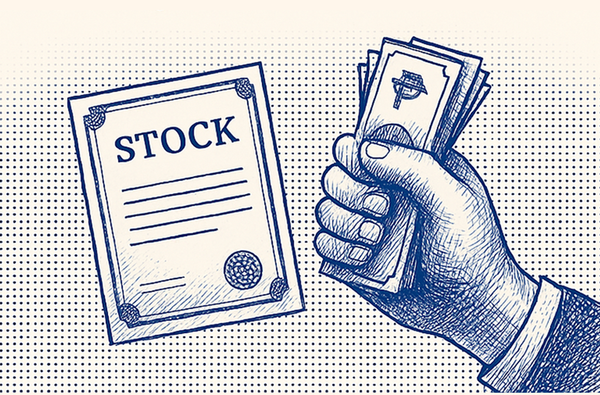How to Estimate A Company's Future Growth
Hype can be unrealistic, and it can fool you into buying dangerous stocks. By learning how to estimate realistic growth rates, you can protect yourself from buying into bad companies.

All hyped-up stocks share one thing in common: The prospect of explosive growth.
Growth - or at least the idea of it - is the driving force behind all hype in history's financial markets. Even those with zero financial background buy into stories of growth.
However, these growth stories can be dangerous.
Many swore that the internet companies of the late 90's would grow for decades, pushing stock prices higher and higher. The few who bothered to look at the financials, however, saw that many of these companies didn't have the financial strength to back up the hype.
In the early 2000's, these companies crashed. Many went bankrupt. The allure of technological advancement couldn't save them from having terrible business fundamentals.
Hype can be unrealistic, and it can fool you into buying dangerous stocks.
It pays to do your own due diligence. By learning how to estimate realistic growth rates, you can protect yourself from buying into bad companies.
The Basics: What making lemonade can teach you about businesses
How does growth work? Here's a metaphor.
Let's say that a lemon contains 100 drops of juice, and you're trying to fill a glass with 180 drops to make some lemonade.
In your kitchen, you have two options: You can squeeze the lemon by hand, yielding 60% of the drops, or you can use a juicer, yielding 90%.
If you do it by hand, you'll need 3 lemons to fill your glass:
- 100 drops per lemon * 60% efficiency = 60 drops per lemon squeezed by hand.
- 180 drops needed / 60 drops per lemon = 3 lemons required
If you use the juicer, you'll only need 2 lemons:
- 100 drops per lemon * 90% efficiency = 90 drops per lemon squeezed using a juicer.
- 180 drops needed / 90 drops per lemon = 2 lemons required
Now let's say you want to make more lemonade. How would you do it? You have 2 ways:
- Use a more efficient method of squeezing lemons
- Get more lemons
Growth doesn't just materialize out of thin air. The growth of your lemonade operation is constrained by your resources and how well you manage them.
Let's translate this analogy to business terms:
There are 2 ways to grow a company's profits:
- Squeeze more profits out of the same resources
- Get more resources
This tells us a lot about the physics of growth: A company that does not make its operations more efficient and does not increase its resources CANNOT grow its income.
The Future Growth Formula
Now that you know the basics of growth, here's a formula you can use to estimate a company's growth rate:
Growth = (Return on Equity) x (Retention Ratio)
Here's a breakdown of the components of the formula:
Return on Equity = (Net Profit) / (Total Equity)
- Return on Equity in our lemon analogy tells us "how efficient we are at squeezing lemons". A higher Return on Equity means that the company can squeeze more profits out of its resources.
- Net Profit is found in the company's income statement.
- Total Equity is found on the company's balance sheet.
Retention Ratio = 1 - (Dividend Ratio)
- Retention Ratio in our lemon analogy tells us "how many new lemons we're adding" to the business. A higher Retention Ratio means that more profits are kept in the company, giving the company more resources in the future to generate profits.
- Dividend Ratio = (Divided Paid) / (Net Profit)
- Dividend Paid is found on the company's equity statement.
- Net Profit is found in the company's income statement.
Understanding Return on Equity
Return on equity, often abbreviated as "ROE", tells us how efficient the company is at using its equity to generate profits. A company with a high ROE is like our lemon juicer - it can squeeze a lot of profits from its resources.
If a company has 100 pesos of equity and is able to generate 10 pesos by the end of the year, then the company would have an ROE of 10% for that year.
ROE is part of the formula because we expect a company to use additional resources with similar efficiency. If a shop has an ROE of 10% and I gave them 100 pesos of equity, they would probably find a way to use that 100 pesos to generate 10 pesos a year - whether by buying more inventory, spending it on marketing, etc.
Understanding Retention Ratio
The retention ratio is the percentage of income that year that is reinvested into the company.
What happens to the profits that aren't reinvested? They're given to shareholders as dividends.
Income that is reinvested can be used as an additional resource to increase profits the following years. In our metaphor, retaining profits is like adding more lemons.
The retention ratio tells us how much profit the company will add to its internal resources to fuel growth. If a car needs additional gas to increase the miles it can travel, a company needs additional cash to increase its ability to make profits.
Interpreting Results
Here are some very general rules of thumb for interpreting the results of this calculation. This is NOT precise, but if you get growth values that are extremely high or low, this will help you know how to feel about those companies.
- A 5% growth rate generally means income growth is stagnant.
- A 10% growth rate generally means income growth is average.
- A 20% growth rate generally means income growth is fast.
An Example
Try following along this example to get some practice.
Let's say we have a company with the following financials:
- Assets = 1,000,000
- Equity = 700,000
- Debt = 300,000
- Profit that year = 70,000
- Dividend that year = 21,000
How do we estimate its income growth for next year?
Remember, here's the formula:
Growth = (Return on Equity) x (Retention Ratio)
Step 1: Get Return on Equity
Return on Equity = Profit / Equity
Profit = 70,000
Equity = 700,000
Therefore:
Return on Equity = 70,000 / 700,000
Return on Equity = 10%
This means that the company is able to squeeze 10 pesos of profits for every 100 pesos it has of equity.
Step 2: Get the Retention Ratio
Retention Ratio = 1 - (Dividend Ratio)
Dividend Ratio = (Divided Paid) / (Net Profit)
Dividend Paid = 21,000
Profit = 70,000
Therefore:
Dividend Ratio = 21,000 / 70,000
Dividend Ratio = 30%
Retention Ratio = 1 - 30%
Retention Ratio = 70%
This means that the company kept 70% of its profits, distributing the rest as dividends.
Step 3: Calculate the Expected Growth Rate
Growth = (Return on Equity) x (Retention Ratio)
Return on Equity (from Step 1) = 10%
Retention Ratio (from Step 2) = 70%
Therefore:
Growth = 10% x 70%
Growth = 7%
This means we can expect the company to grow its income by approximately 7% next year.
Conclusion
It's easy to get swayed by stories about people making tons from hyped-up stock picks.
Knowing how to calculate growth rates is one way to protect yourself from buying into bubbles. Knowing a company's reasonable expected growth rate anchors your expectations.
The stock market is a great tool for increasing your wealth, but it's also filled with traps and unsubstantiated hype. I hope this formula helps you avoid these pitfalls.



